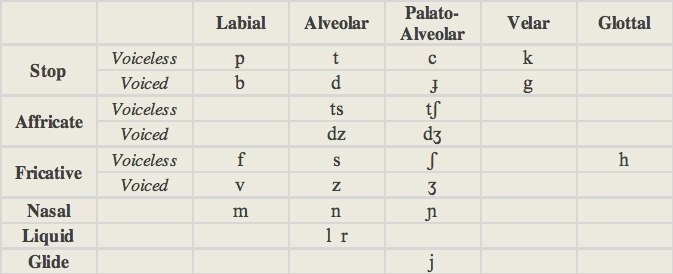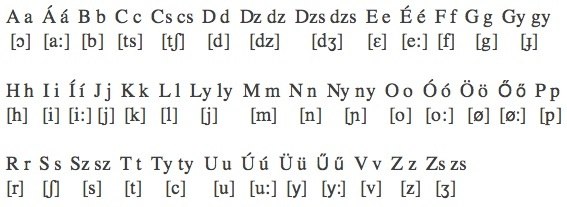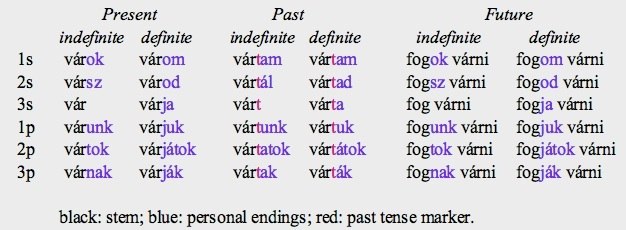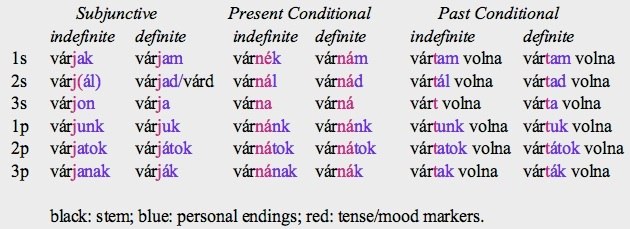An insatiable appetite for ancient and modern tongues


Alternative Name: Magyar.
Classification. Uralic, Finno-Ugric, Ugric, Hungarian.
Overview. Hungarian is the largest Uralic language with more than half of all the speakers of the family. It is atypical within Uralic and has no close relatives. The other members of the Ugric subgroup are radically different from Hungarian in their phonology, syntax and vocabulary. This is due to the early and far-reaching migrations of the Hungarian ancestors into very different cultural and linguistic areas. The Proto-Hungarians migrated first southward from their Uralic homeland into the South Russian steppe and then westward into Central Europe. Hungarian is an agglutinative language with a very rich case system and a mixed vocabulary reflecting the history and migrations of the Hungarians.
Distribution. Hungarian is the only Uralic language spoken in Central Europe, above all in Hungary but also in the Transylvanian region (that belongs to Romania from 1918), as well as in Serbia, Slovakia and Ukraine.
Speakers. Hungarian is spoken by about 13 million people in the following countries:
Hungary
Romania
Serbia
Slovakia
Ukraine
USA
Canada
Israel
Austria
Croatia
Czech Republic
10,000,000
1,500,000
500,000
500,000
180,000
92,000
90,000
70,000
26,000
17,000
15,000
Status. It is the national and official language of Hungary and has been granted regional status in Serbia, Slovakia, Slovenia and Austria.
Oldest Documents
1200 CE. Hallotti Beszéd (Funeral Oration). A translation of a Latin text.
1300 CE. Ómagyar Mária-siralom (Old Hungarian Lament of the Virgin Mary) is the oldest extant poem written in Hungarian.
Phonology
Vowels (14). Hungarian has a vowel system with seven pairs of vowels, each including a short and a long vowel. In two pairs the short and long vowel differ also in quality: [ɛ] [e:]; [ɔ] [a:]. Vowel length is fully recognized in the Hungarian alphabet and it is phonemic.

Vowel Harmony. Hungarian exhibits vowel harmony only in suffixal vowels. It affects the relation front vs. back, as well as the roundness of vowels in certain suffixes. Another prevalent vowel alternation is that of the short mid vowels with zero.
Consonants (25). Hungarian has a rich inventory of voiced/voiceless oppositions between stops, affricates and fricatives.

Stress. It falls invariably on the first syllable of the word.
Script and Orthography
The Hungarian alphabet has 40 letters which correspond exactly with the 14 basic vowel sounds and 25 consonants of the language (one letter is redundant: j and ly are pronounced alike). It is remarkable by its use of several digraphs and one trigraph. Long vowels are distinguished by an acute accent (which is doubled in the front rounded ones).

Morphology. Hungarian has an agglutinative morphology of the suffixing type.
-
Nominal. Noun stems may end in either a consonant or a vowel. Nouns are inflected for number, person and case by adding suffixes to the stem in this order: number + person + case. Any or all of these three slots may be occupied by a zero suffix. If there is no number suffix, the noun is in the singular; if there is no person suffix there is absence of possessor; if there is no case suffix, the noun is in the nominative. Attributive adjectives are invariable; however they can all be used as nouns and are, then, declined fully.
-
•number: singular, plural. The plural markers are the suffixes -k and -i. The first one is used when there is no possessor suffix and the second when there is one. When the noun stem ends in a consonant, the plural suffix is linked to it via a harmonic vowel (a/e). Numerals make redundant the plural marking of the noun.
-
•gender: there is no grammatical gender; natural gender may be indicated by appropriate nouns e.g. tanár (teacher), tanárnő (female teacher).
-
•possession: is indicated by suffixing an enclitic personal pronoun after the plural suffix (if it is present) and before the case suffix.
-
•case: Hungarian has between 17 to 25 cases. They are divided into two groups:
-
a)syntactical cases: nominative (unmarked), accusative, dative, instrumental, essive, causal-final, translative, terminative. They indicate the relationship of the noun to other words in the sentence. The nominative marks the subject and the accusative the direct object. The dative marks not only the indirect object but also possession or a predicate construed with an infinitive. The instrumental signals the instrument with which an action is carried out. The essive marks a temporary location or state of being equivalent to English 'as'. The causal-final indicates purpose. The translative indicates transformation into another state. The terminative is equivalent to English 'until'.
-
b)locative cases: denote various spatial and kinetic oppositions like stationary vs moving, motion toward vs motion away, interior vs exterior, near vs far. They are shown in the following table:

-
•pronouns: personal, demonstrative, interrogative, relative, reflexive, possessive, indefinite.
-
Personal pronouns have nominative, accusative and enclitic forms:

-
The demonstratives (pronouns or adjectives) are: ez (‘this’), ezek (‘these’), az (‘that’), azok (‘those’). They are declined in all cases (syntactical and locatives).
-
The interrogative pronouns are ki (‘who?’) and mi (‘what?’), that decline like regular nouns and can be singular or plural, and melyik (‘which?’) that has the plural form melyek.
-
Hungarian has several relative pronouns: aki (‘who’), colloquial ami (‘what, which, that’), formal amely (‘what, which, that’). Other relative pronouns are formed by prefixing a- to an interrogative pronoun e.g. amelyik.
-
The reflexive pronouns are the possessive forms of the stem mag-: magam (1st. sg.), magad (2nd. sg.), maga (3rd. sg.); magunk (1st. pl.), magatok (2nd. pl.), maguk (3rd. pl.).
-
Possessive pronouns must be preceded by the definite article; they distinguish between singular and plural possession. For example: az enyém (‘mine’, singular possession), az enyéim (‘mine’, plural possession); a mienk (‘ours’, singular possession), a mieink (‘ours’, plural possession).
-
Indefinite pronouns are formed by prefixing vala- to the interrogatives: valaki (‘someone’), valami (‘something’), valamelyik (‘one or the other’).
-
•articles: the definite article is a before consonants and az before vowels. This article is invariable for number and is assimilated to postpositions. The indefinite article egy (‘a, an’) is identical to the numeral one.
-
Verbal. All Hungarian verb stems end in a consonant or a consonant cluster. The stem is the citation form of the verb (the one found in dictionaries); it is identical with the 3rd person singular of the present indefinite.
-
Every conjugated verb consists of a stem followed by a tense/mood suffix and person/number endings. There is a large system of preverbal particles or prefixes, called coverbs, that may be attached to the stem to mark aspect or to indicate the manner of an action or the direction of motion, like be (into), ki (out of), le (down), át (through) and vissza (back).
-
For each mood and tense, verbs have two conjugations. The definite conjugation is used if the sentence contains a definite direct object, the indefinite conjugation in all other cases. A direct object is considered definite when it is preceded by the definite article or it has a possessive suffix or it is a demonstrative pronoun or it is a 3rd person pronoun (overt or implied).
-
•person and number: 1s, 2s, 3s; 1p, 2p, 3p.
-
•tense: present, past, future. The present has no tense suffix, the past is marked by a specific suffix (-t/-ott/-ött/-et) and the future is made with the present of the auxiliary verb fog ('will') + the infinitive. Depending on various circumstances, this auxiliary may be placed before or after the infinitive. The conjugation of vár ('wait') is:

-
•mood: indicative, subjunctive-imperative, conditional. The subjunctive is also used for the imperative; it is marked by the infix -j-. The present conditional is marked by the infixes -né-, -ná-, -na-. The past conditional is formed with the past tense of the verb followed by volna ('would').

-
•aspect: imperfective, perfective. Perfective aspect is marked by coverbs like meg and el. In the past tense it indicates that an action has been completed; in the present tense it indicates that an action will be completed in the future. An absence of coverb indicates imperfective aspect (incomplete action).
-
imperfective perfective
-
írtam egy levelet ('I was writing a letter') megírtam a levelet ('I wrote the letter')
-
olvassa a könyvet ('he is reading the book') elolvassa a könyvet ('he will read the book')
-
Note: the -ja ending of the 3rd person definite is assimilated to the s of olvas by becoming -sa.
-
-
•voice: active. The passive voice is no longer used, but 3rd. plural conjugations without a subject, or with a subject pronoun, may have a passive sense.
-
•derivational conjugations: causative, potential, frequentative.
-
The causative is made by attaching -at/-et or -tat/-tet to the stem to indicate that the subject has something done; afterwards the verb is conjugated as usual: várattok ('I have somebody wait').
-
The potential adds -hat/het to the stem to express possibility or capability: várhatok ('I may play').
-
The frequentative expresses a repetitive, long or aimless action: it is usually formed by attaching -gat/-get to the stem.
-
•non-finite forms: infinitive, present participle, past participle, future participle, adverbial participle.
-
The infinitive ending is -ni which is attached directly to the stem. Besides this infinitive, used as a complement to other verbs, there is a declined infinitive employed in impersonal constructions.
-
The present participle is formed by adding the suffix -ó to the stem; the past participle is usually the same as the 3rd person singular indefinite; the future participle adds -andó/-endő to the stem, and the adverbial participle -va/-ve to it. The latter expresses an action that is simultaneous to that of a conjugated verb.
-
• infinitive: várni (to wait)
-
• present participle: váró (waiting)
-
• past participle: várt (awaited).
-
• future participle: várandó (to be expected)
-
• adverbial participle: várva ([while] waiting)
Syntax
In Uralic languages word order is variable. Some are Subject-Object-Verb (SOV), others are Subject-Verb-Object (SVO) and in others it is quite free. Due to the influence of European languages (belonging to the Indo-European family). Hungarian has a predominant SVO order.
The noun phrase is head-final. Modifiers, including genitives, precede their heads. Besides word order, syntactical relations are indicated by a combination of case marking and postpositions. Articles and attributive adjectives do not agree with the head noun, demonstratives alone agree in number and case with their head.
Lexicon
Hungarian has a great number of lexical borrowings as a consequence of successive migrations into different linguistic and cultural environments. The oldest borrowings are, surprisingly, from Iranian. The most numerous are from Slavic and Turkic. Direct borrowings from Latin are also substantial although mostly limited to Christian terminology. Germanic borrowings are in the hundreds. From the Romance languages the most recent loanwords are from Romanian and the most abundant from Italian.
Basic Vocabulary
one: egy
two: két, kettő
three: három
four: négy
five: öt
six: hat
seven: hét
eight: nyolc
nine: kilenc
ten: tíz
hundred: száz
father: apa, atya (an older form)
mother: anya
brother/sister: testvér
brother: fivér
brother (elder): báty
brother (younger): öcs
older sister: nővér
younger sister: húg
son: fiú
daughter: lány
head: fej
face: arc
eye: szem
hand: kéz
foot: láb
heart: szív
tongue: nyelv
Key Literary Works
1575-94 Poems. Bálint Balassi
-
Balassi is famous now for his love lyrics though they were not published in his lifetime. Ranging from the idealistic to the sensual, they were vivified by new rhyming schemes that contrasted with the rather monotonous ones of earlier poets. He composed also songs of war based on his own experiences as a soldier and religious poems addressed to a very personal God.
-
1651 Szigeti veszedelem (The Peril of Sziget). Miklós Zrínyi
-
An epic poem on the siege in 1566 of the fortress of Szigetvár, defended heroically but unsuccessfully by the poet's great-grandfather against the Turks. Although Zrínyi and his soldiers died, the Turks suffered heavy losses and the famous Sultan Suleiman the Magnificent was killed in the fight. In spite of being influenced by classical epics, this one strikes an original tone and gives a sense of authenticity because of the familiar connection of the author and of his extensive experience in military matters.
-
1821 Bánk bán (The Palatine Bank). József Katona
-
Set in the 13th century and based on historical facts, this play in five acts is a tragedy of conflicting loyalties. Bánk had a high position in court but while King Andrew II (1205-35) was away he murdered his foreign queen delivering justice by his own hand. The characters are complex and their psychology rings true. Among them, one unforgettable is the serf Tiborc who is a symbol of the oppressed.
-
1845 Afalu jegyzője (The Village Notary). József Eötvös
-
An early novel depicting the evils of the feudal society. The hero, the liberal village notary of the title, loses his political rights when his identity papers are stolen by his corrupt enemies. Without them he cannot prove that he belongs to the nobility and is, thus, unable to be a candidate in the upcoming elections. He is helped by a former farmer who suffered injustice and became a serf and an outlaw…
1844-56 Poems. Sándor Petőfi
-
Universally acknowledged as one of the greatest Hungarian poets, Petőfi was an innovator in poetic diction and subjects. Closer to the spoken language than those of his predecessors, his poems are often based on folk-songs and range from the amatorial to the political and from the bucolic to the patriotic.
-
1847 Toldi. János Arany
-
A narrative poem, the first part of a trilogy, protagonized by the semi-legendary medieval hero Miklós Toldi, a peasant of immense strength who after numerous adventures became a knight by virtue of his bravery. The second and third parts of the trilogy, 'The Love of Toldi' and 'Toldi's Eve', took thirty years to complete.
-
1861 Az ember tragédiája (The Tragedy of Man). Imre Madách
-
A poetic drama that follows man's fate from creation up to a remote future. Adam, Eve and Lucifer travel through time to key periods in human history. When in each of them, Adam's dreams about mankind are revealed as futile and Lucifer tries to convince him about the meaningless of life, Eve appears just in time to encourage Adam. In the end when he is ready to kill himself to prevent the failure of man, Eve announces that she is pregnant.
-
1975 Sorstalanság (Fatelessness). Imre Kertész
-
György, a 14-year old assimilated Hungarian Jew, is picked up from the streets of Budapest in 1944 and sent to various concentration camps. Camp life is seen through his eyes. György's account is detached and devoid of emotion. One year later he is liberated and returns to Budapest to find the scorn of many people and his apartment taken by another family. Now, anger surfaces and he ponders about the meaning of his terrible experience.
-
1977 Egy családregény vége (The End of a Family Story). Péter Nádas
-
In Stalinist Hungary a young boy (the narrator) lives alone with his grandparents. His Jewish grandfather entertains him with fantastic stories about the family's past, the Bible and the Talmud. They discover that the boy's father, a government official, has become himself a victim of the police state.
-
1982 A cinches (The Loser). György Konrád
-
A Hungarian intellectual and former high-ranking Communist official, held in a psychiatric hospital, recalls his life before and after Communism. Resorting to modernist techniques, including stream of consciousness and juxtaposed memories, the transformation of Hungary into a Communist state is depicted with its unending fights for power, cruelty and corruption. In the end, the protagonist prefers to stay in the asylum where he feels protected from the dangers and madness of the outside world.
-
1985 Sátántangó (Satan's Tango). László Krasznahorkai
-
This novel is the story of a tiny rural Hungarian village and its miserable inhabitants affected by the collapse of their collective farm near the end of Communism. A false, charismatic, prophet appears… The atmosphere is bleak, reality seems to fall apart…
-
1989 Az ellenálás melankóliája (The Melancholy of Resistance). László Krasznahorkai
-
A strange circus arrives to a small Hungarian town triggering a series of chaotic events in a society that is already disintegrating.
-
1990 Kaddis a meg nem születetett gyermekért (Kaddish for an Unborn Child). Imre Kertész
-
The kaddish is a Jewish prayer for the dead. Here, it is addressed metaphorically to the child the protagonist refused to have. He is a survivor of a Nazi concentration camp who does not want to become a parent in a world that has given birth to the Holocaust. In a dense text written in a stream of consciousness technique, without chronological order, he re-assesses the reasons he gave his ex-wife for his refusal and her counter arguments.
-
© 2013 Alejandro Gutman and Beatriz Avanzati
Further Reading
-L’Edification de la Langue Hongroise. A. Sauvageot. Klincksieck (1971).
-The Hungarian Language. L. Benko & S. Imre (eds). Mouton (1972).
-Hungarian. I. Kenesei, R. M.Vago & A. Fenyvesi. Routledge (1998).
-Hungarian: An Essential Grammar. C. Rounds. Routledge (2001).
-The Syntax of Hungarian. K. Kiss. Cambridge University Press (2002).
-Hungarian Inflectional Morphology. D. Abondolo. Akadémiai Kiadó (1988)
-The Oxford History of Hungarian Literature. L. Czigány. Clarendon Press (1984).
Hungarian

Address comments and questions to: gutman37@yahoo.com
MAIN LANGUAGE FAMILIES
LANGUAGE AREAS
Languages of Ethiopia & Eritrea
LANGUAGES by COUNTRY
LANGUAGE MAPS
-
• America
-
• Asia
-
Countries & Regions
-
-
Families
-
• Europe
-
• Oceania